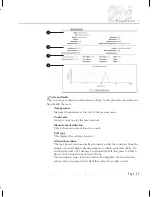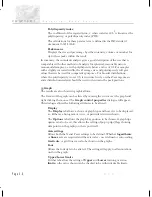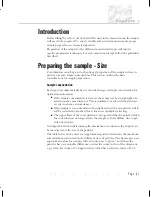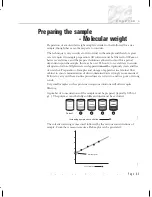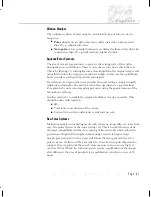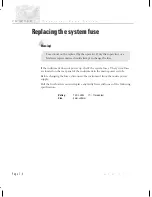
Particle size
Min. Concentration
(Recommended)
Max. Concentration
(Recommended)
< 10nm
0.5g/l
Only limited by the sample material
interaction, aggregation, gelation etc.
10nm to 100nm
0.1mg/l
5% mass (assuming a density of 1g/cm
3
)
100nm to 1µm
0.01g/l (10
-3
% mass)
1% mass (assuming a density of 1g/cm
3
)
> 1µm
0.1g/l (10
-2
% mass)
1% mass (assuming a density of 1g/cm
3
)
Whenever possible, the sample concentration should be selected such that the
sample develops a slightly milky appearance - or in more technical terms, gets
slightly turbid.
If such a concentration cannot be selected easily (for example, the particle size of
the sample may be so small that even concentrated dispersions show no
turbidity), various concentrations of the sample should be measured in order to
detect and then avoid concentration dependent effects (i.e. particle interactions
etc). A concentration should be chosen such that the result is independent of the
concentration chosen. However, these effects do not normally appear at
concentrations below 0.1% by volume.
Be aware that particle interactions may occur at sample concentrations larger than
1% by volume - particle interactions will influence the results.
Considerations for small particles
Minimum concentration
For particle sizes smaller than 10nm, the major factor in determining a minimum
concentration is the amount of scattered light that the sample generates. In
practice, the concentration should generate a minimum count rate of 10,000
counts per second (10kcps) in excess of the scattering from the dispersant. As a
guide, the scattering from water should give a count rate in excess of 10kcps, and
toluene in excess of 100kcps.
Maximum concentration
For samples with small particle sizes, a maximum concentration does not really
exist (in terms of performing Dynamic Light Scattering (DLS) measurements).
However, in practice, the properties of the sample itself will set the maximum
value. For example, the sample may have the following properties:
.
Gelation
. A gel is unsuitable for measurement using the Zetasizer (this is
true for all instruments based on Dynamic Light Scattering).
C H A P T E R 6
Z
e
t
a
s
i
z
e
r
N
a
n
o
S
e
r
i
e
s
P a g e 6 . 2
M
A
N
0
3
1
7
Summary of Contents for Zetasizer Nano Series
Page 7: ...Part 1 Operators guide Part 1 Operators guide...
Page 8: ......
Page 9: ...Introduction to this manual Introduction to this manual C H A P T E R 1...
Page 10: ......
Page 16: ...C H A P T E R 1 Z e t a s i z e r N a n o S e r i e s Page 1 6 M A N 0 3 1 7...
Page 17: ...What is the Zetasizer Nano What is the Zetasizer Nano C H A P T E R 2...
Page 18: ......
Page 26: ...C H A P T E R 2 Z e t a s i z e r N a n o S e r i e s Page 2 8 M A N 0 3 1 7...
Page 27: ...How does the Zetasizer Nano work How does the Zetasizer Nano work C H A P T E R 3...
Page 28: ......
Page 51: ...Making measurements A tutorial Making measurements A tutorial C H A P T E R 4...
Page 52: ......
Page 78: ......
Page 90: ...C H A P T E R 5 Z e t a s i z e r N a n o S e r i e s Page 5 12 M A N 0 3 1 7...
Page 91: ...Sample Preparation Sample Preparation C H A P T E R 6...
Page 92: ......
Page 100: ...C H A P T E R 6 Z e t a s i z e r N a n o S e r i e s Page 6 8 M A N 0 3 1 7...
Page 101: ...Maintenance Maintenance C H A P T E R 7...
Page 102: ......
Page 107: ...Part 2 Supervisors guide Part 2 Supervisors guide...
Page 108: ......
Page 109: ...Security Security C H A P T E R 8...
Page 110: ......
Page 118: ...C H A P T E R 8 Z e t a s i z e r N a n o S e r i e s Page 8 8 M A N 0 3 1 7...
Page 119: ...Using SOPs Using SOPs C H A P T E R 9...
Page 120: ......
Page 152: ......
Page 161: ...Exporting results Exporting results C H A P T E R 1 1...
Page 162: ......
Page 168: ...C H A P T E R 1 1 Z e t a s i z e r N a n o S e r i e s Page 11 6 M A N 0 3 1 7...
Page 169: ...Creating custom reports Creating custom reports C H A P T E R 1 2...
Page 170: ......
Page 183: ...Size theory Size theory C H A P T E R 1 3...
Page 184: ......
Page 193: ...Molecular Weight theory Molecular Weight theory C H A P T E R 1 4...
Page 194: ......
Page 200: ...C H A P T E R 1 4 Z e t a s i z e r N a n o S e r i e s Page 14 6 M A N 0 3 1 7...
Page 201: ...Zeta Potential theory Zeta Potential theory C H A P T E R 1 5...
Page 202: ......
Page 215: ...Part 3 Appendices Part 3 Appendices...
Page 216: ......
Page 217: ...Health and Safety Health and Safety A P P E N D I X A...
Page 218: ......
Page 223: ...Specification Specification A P P E N D I X B...
Page 224: ......
Page 227: ...Site requirements f r o m M A N 0 3 1 7 I s s u e 1 0 Site requirements A P P E N D I X C...
Page 237: ...Installation Installation A P P E N D I X E...
Page 238: ......
Page 241: ...Regulatory Statements Regulatory Statements A P P E N D I X F...
Page 242: ......
Page 246: ...A P P E N D I X F Z e t a s i z e r N a n o S e r i e s Page F 4 M A N 0 3 1 7...
Page 247: ...Index Index...
Page 248: ......


